In the last post I said that along with the changing of seasons comes my incessant desire to eat sweet potatoes 24/7 – did you think I was kidding?
With pumpkin spice lattés, popcorn, cookies, hand soap (yes, hand soap), and other souvenirs, it’s hard not to want in on the craze, no matter how much of a marketing trap it may be. If you follow a lectin-limited diet though, you’re probably not going to be eating much pumpkin this year, as it’s part of the “forbidden food” list, along with other squashes. While I’m not saying that the rules aren’t not meant to be broken from time-to-time, we’re gonna miss out on our fair share of pies this year…
Unless we replace everything that has pumpkin in it with… SWEET POTATO. Surely, this is the cure for our dilemma!

Technically speaking, pumpkins and sweet potatoes are drastically different botanical creatures; a pumpkin is a seed-containing gourd that belongs to the Cucurbitaceae family that grows on vines above ground, whereas a sweet potato is an underground tuber that belongs to the bindweed or Morning Glory family. But, technicalities aside, the 7 year old me sure as hell wouldn’t be able to tell the difference between a sweet potato pie from a pumpkin pie.
After all, it’s really the mixture of cinnamon, ginger, cloves, and nutmeg – deemed “pumpkin pie spice” – that we’re after, not the delivery device in question. So, if we combine “pumpkin pie spice” with sweet potatos, who’s gonna know the difference?
At Starbucks, the pumpkin spice “sauce” is what transforms a typical, rather lackluster latté into a sweet, Fall flavored masterpiece, so I figured to create a killer sweet potato spice latte, I would first need a killer “sauce” or syrup.
To do such a thing, I boiled a jewel sweet potato until fork tender, created a simple syrup of erythritol (an alcohol sugar) and water, formulated a homemade “pumpkin pie spice” blend – because freshly ground spices are always better than the store bought stuff – and blended them all together, along with some vanilla extract and a ‘lil pinch of salt, until smooth. The result is a heavily concentrated, thick, sweet sauce, that closely resembles the one I was familiar with back when I worked at Starbucks.
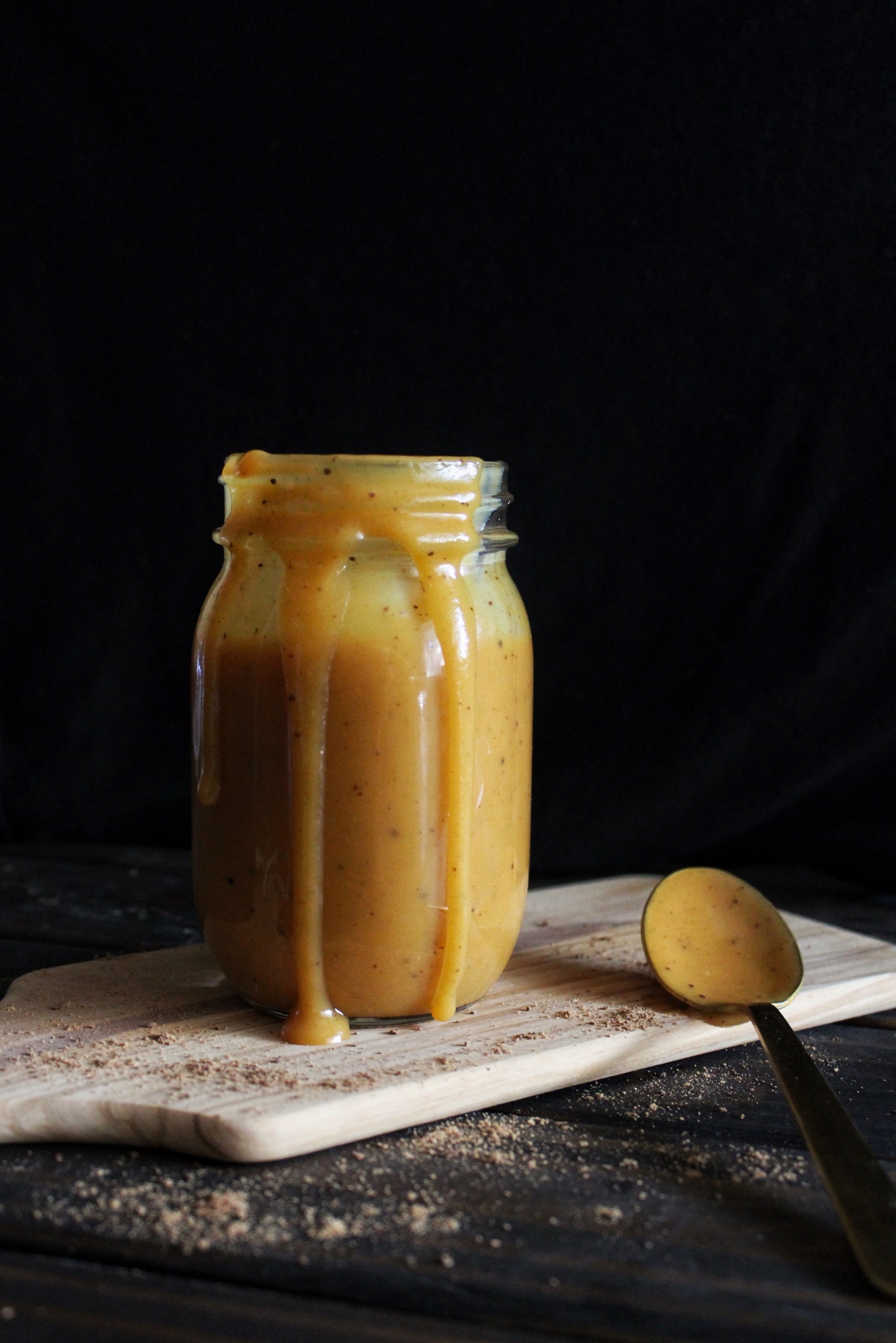
Being that I don’t have an espresso maker, I decided to use the one coffee brewing device I always have on hand: the French Press. To replicate the effect of espresso in a latté, simply brew the coffee at triple strength, and then combine it with steamed milk, that way the final drink is strong in coffee flavor, yet still comprised of mostly milk.
For a normal 12 oz cup of coffee, I use 30 grams of coffee and 12 oz of water (plus more for evaporation and absorption). For this coffee concentrate, I use the same 30 grams of ground coffee, but with 4 oz of water (plus more for evaporation and absorption), which then equates to 6 oz of water per latte.
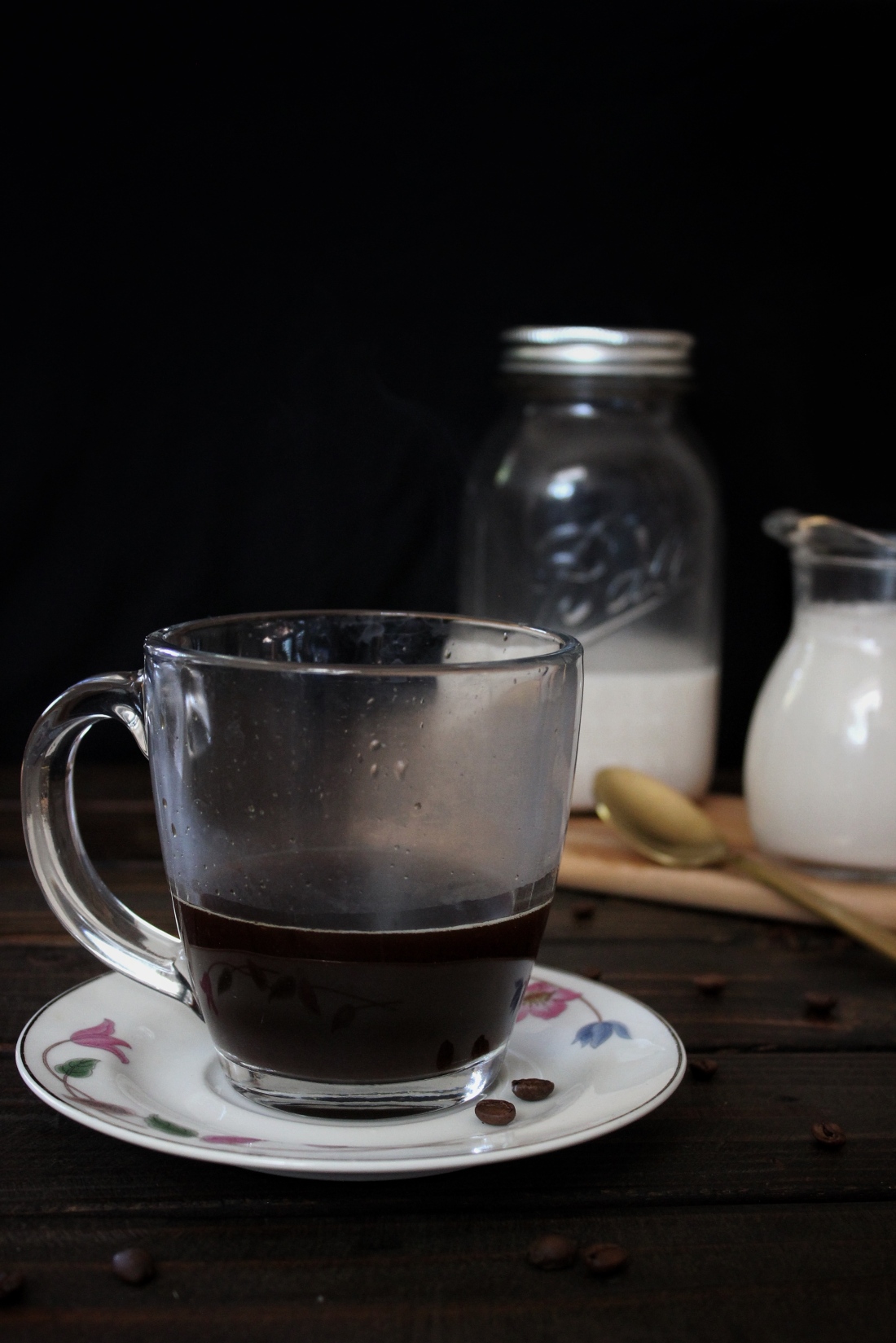
The quality of coffee you choose directly effects the taste, mouth feel, and body feel (healthiness) that this drink has. I highly recommend that you buy whole, local beans that’ve been roasted within the past two weeks, because such beans contain the highest concentrations of antioxidants and essential oils.
Only recently was I fortunate enough to receive a hand held bur grinder from a friend (thank you Luis!), so I understand if you don’t have the means to grind your own coffee right before consumption every time. If you can’t grind your own coffee at home, then buy beans whole then have them ground at the grocery store or a coffee shop – you may be surprised how many grocery stores have coffee grinders and how many local coffee shops are willing to grind your beans for you.
That being said, I highly recommend getting a hand-operated burr grinder, because they’re affordable, reliable, and break down coffee beans into a consistent sized grind; if you use an electric coffee grinder, you’ll likely end up with large chunks of coffee among really fine dust, which results in uneven extraction.
For proper brewing in a French Press, you want to grind your beans on “coarse,” or simply, “French Press,” setting; since a French Press steeps coffee over the course of 4 minutes, the grounds need to be coarser than a pour over’s coffee, where the brewing process only takes 1 to 2 minutes.
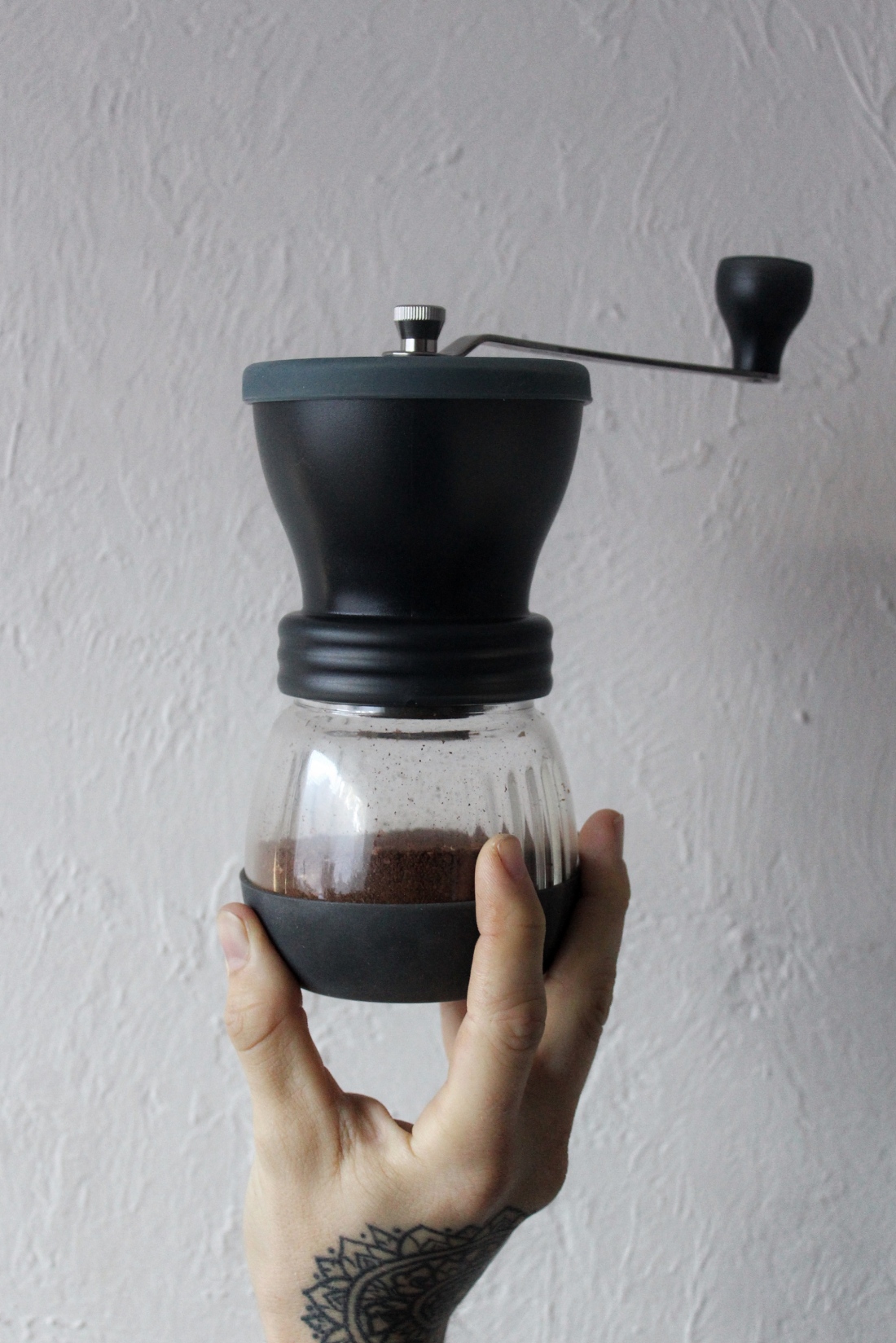
Another key element to any latté is the milk that is to be used. On the West Coast, milk alternatives are debatably more popular in coffee shops than regular ‘ole cow juice – way to go West Coast! Unfortunately, most dairy alternatives contain some form of sugar or are derived from a lectin-containing source (i.e. oat or soy milk), which puts them out of the range of possibility for me. Fortunately, at home, we have the luxury to choose whatever milk we’d like to use, even if that means making our own.
While I normally use coconut milk for EVERYTHING, a milk with a lighter body and nuttier flavor is a nice compliment to the spices in this latté, so we decided to make hazelnut milk, which contains two ingredients: hazelnuts & water. And guess what? The process only takes two steps: blend hazelnuts and water together then strain through a cheesecloth or nut milk bag.
Although, if making homemade nut milk isn’t your forte, go with unsweetened almond, hemp, or light coconut milk. While I’m all about the healthy fats in full-fat coconut milk, it’s too rich to include 8 oz of in a latte. But – if that’s all you got – you can mix 1 part full-fat coconut milk with three parts water to achieve the same effect as “light coconut milk.” In this recipe, for example, you could use 5 oz water + 3 oz full-fat coconut milk.
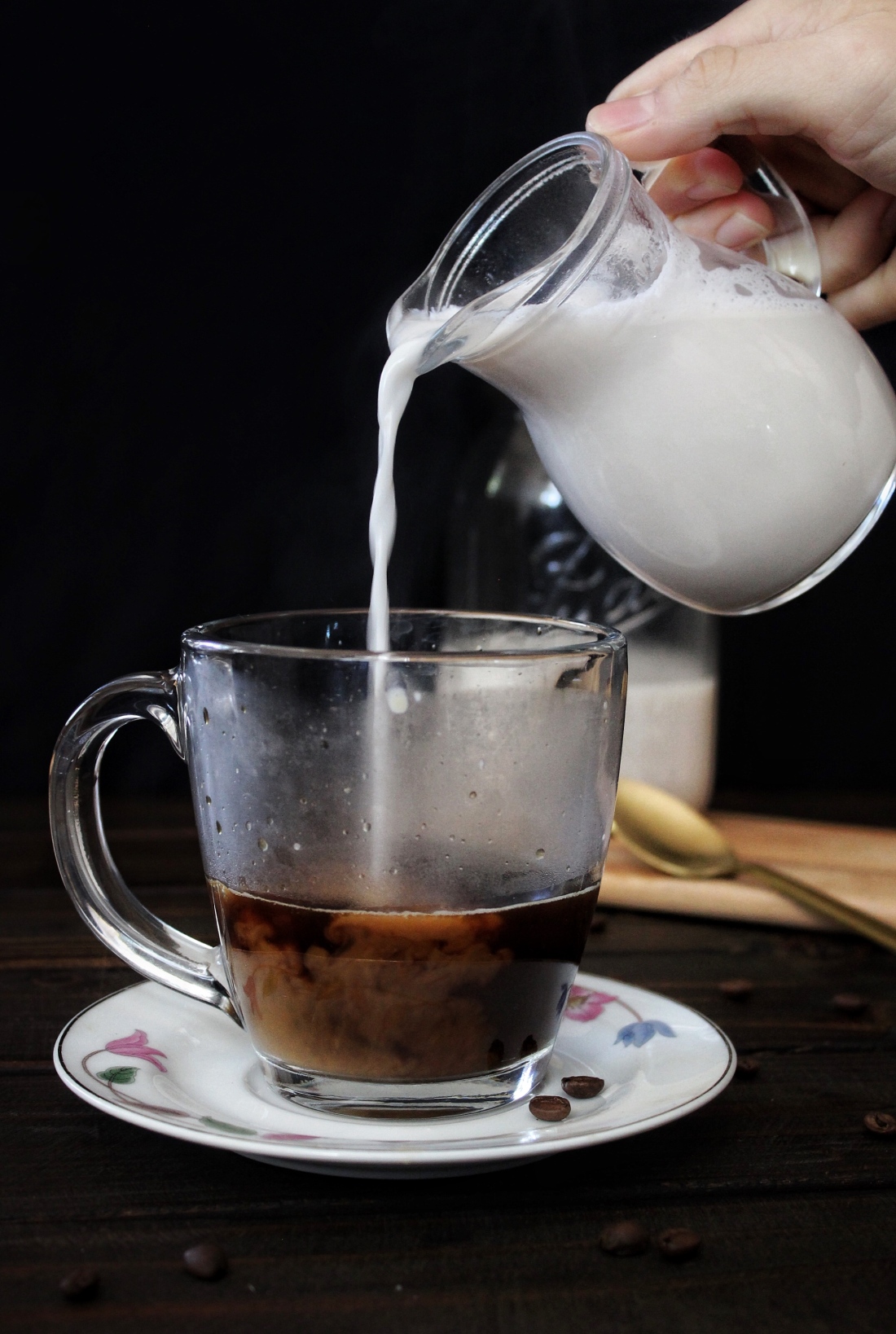
If you didn’t read our last post on Fluffy Sesame Muffins (which these pair beautifully with), you may be wondering, “What in the world is erythritol and is it safe?”
If so, here’s a little info on the subject:
“Coincidentally, erythritol isn’t a sugar or an alcohol.
Rather, chemically, it’s a “resistant starch,” meaning a starch that’s fermented in the colon, where it’s converted into short-chain fatty acids by gut bacteria. Unlike sucrose or glucose, erythritol doesn’t require insulin to be digested, thus it doesn’t spike insulin levels or raise blood pressure. Because sugar alcohols act as food for good gut bacteria, they’re able to multiply their population, creating a thicker wall of intestinal mucous, which keeps lectins out of the bloodstream and helps repair leaky gut.
Another thing the processing of sugar alcohols does is create flatulence… as in gas. For this reason, some people experience abdominal discomfort after eating too much alcohol sugars.
But don’t get all sad faced emoji on us yet; thankfully, there’s more than one type of alcohol sugar, including: xylitol, erythritol, sorbitol, isomalt, mannitol, and more.
The body processes all of these differently, with a certain percentage being passed through the kidneys as urine (undigested) and another percentage is processed as resistant starch and turned into gas in the colon (digested). The more sugar alcohol that goes undigested, the less gas you will experience. The more sugar alcohol that’s digested, the more gas you will experience.
Erythritol has the highest amount that goes undigested at 90%, which is drastically different than xylitol, where only 20% is undigested.”
I hope that clears up some questions you may have about this useful, yet somewhat mysterious sugar alcohol.
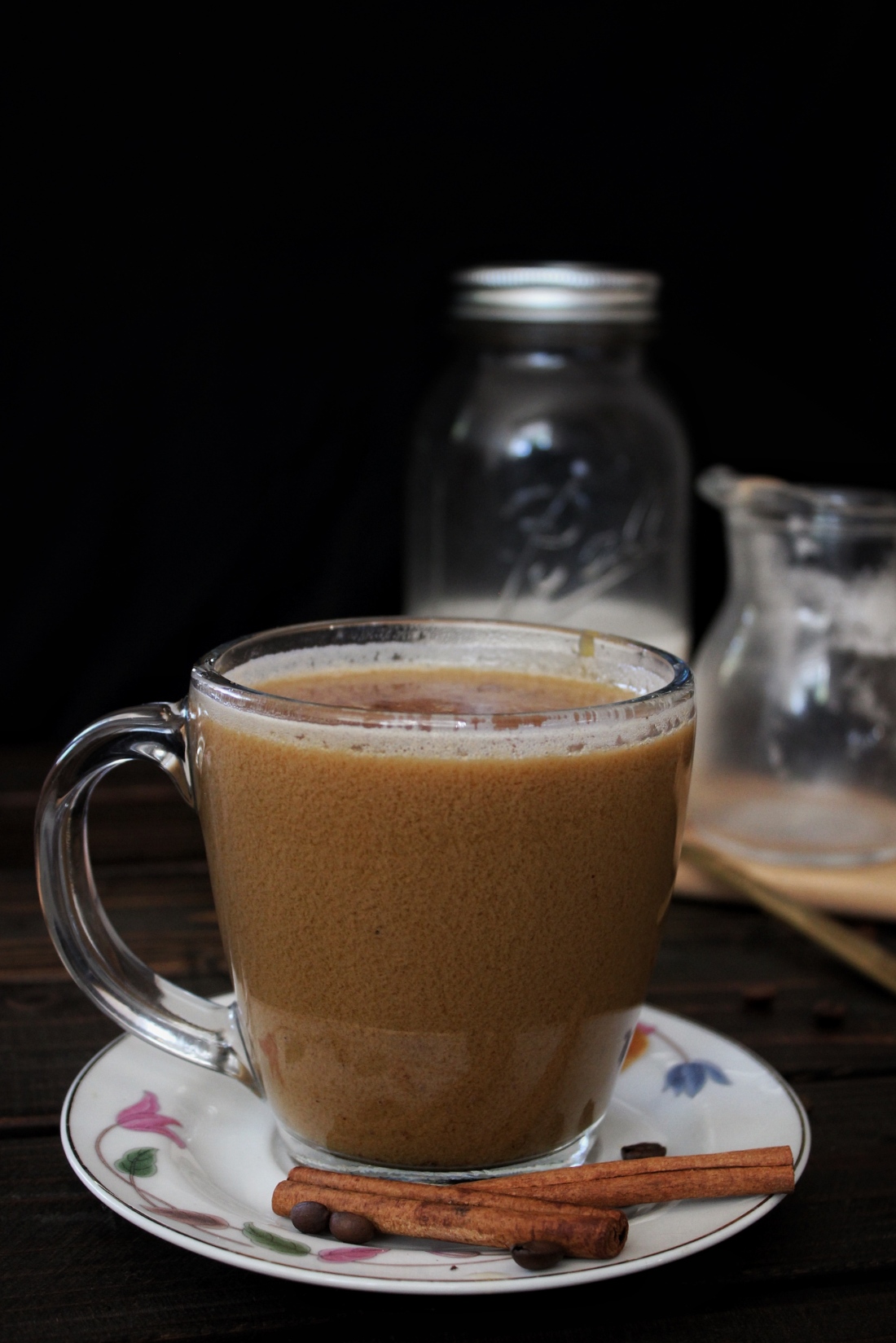
All in all, this latte is: Fall-spiced, creamy, sweet, and reminiscent of that we drink we all love to hate…
We hope you now see that any one of us can whip up a darn good latte in our own home and – with a few appropriately placed substitutions – none of us have to miss out on our favorite Fall treats.
If you like what your taste buds are tellin’ ya, leave behind a nice rating, share your thoughts with us in the comments, or show us your creations by tagging @noeggsorham on Instagram.
Cheers to the Fall!
Ryan & Kim
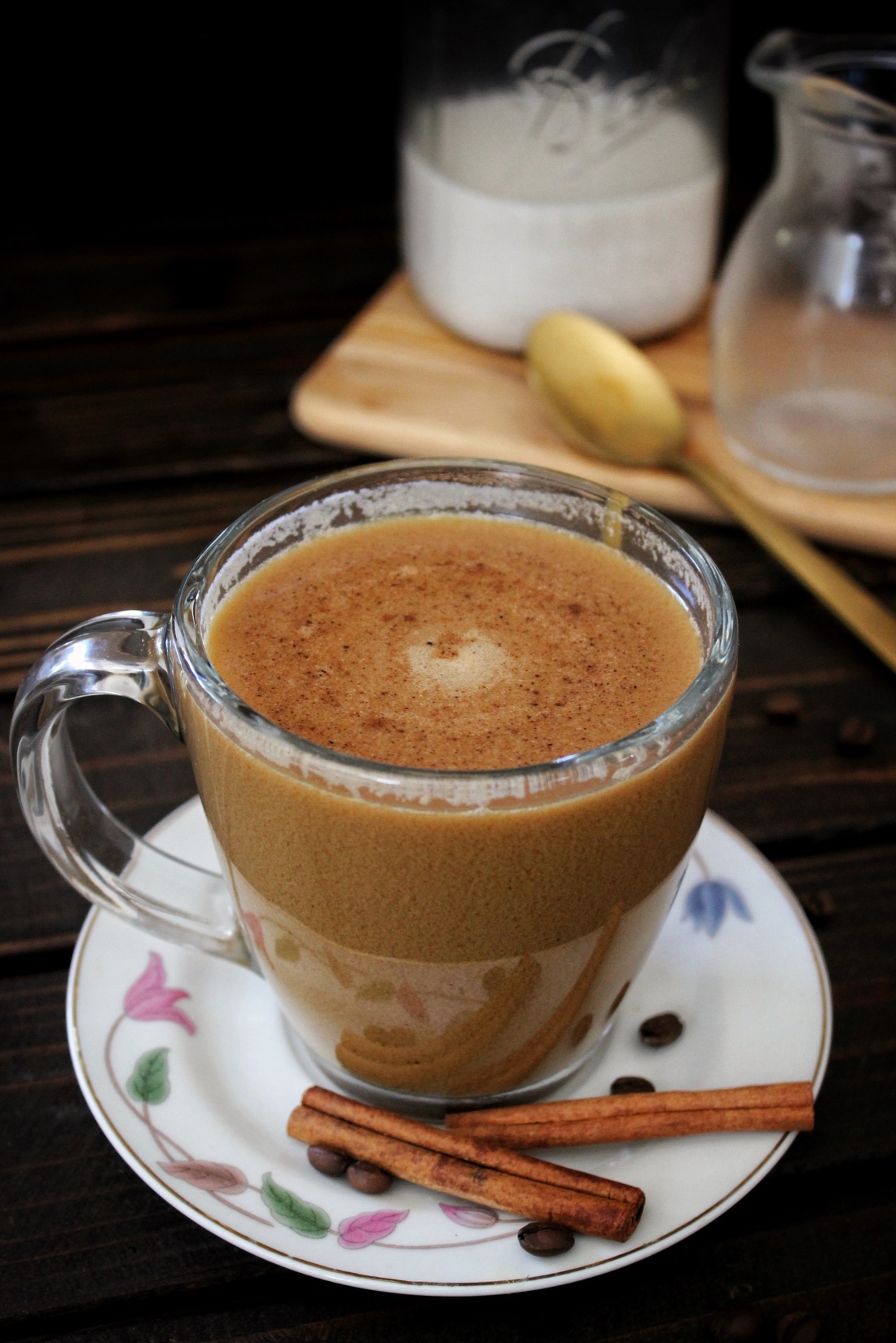
Sweet Potato Spice Latté
Steamed hazelnut milk, pumpkin pie spiced syrup, and masterly brewed coffee concentrate come together to form two heart warming, campfire cuddling lattés.
Ingredients
Pumpkin Pie Spice
- 15 g cinnamon sticks (3 2-inch sticks)
- 8 g dried ground ginger (4 tsp)
- 5 g nutmeg, freshly ground (1 3/4 tsp)
- 2 g cloves, whole (2 tsp whole)
Sweet Potato Syrup
- 8 oz orange sweet potato, peeled and cubed (1/2 medium sweet potato)
- 1/2 c water
- 1/2 c erythritol
- 1 tsp pumpkin pie spice (recipe above)
- 1/2 tsp vanilla extract
- Small pinch of salt
Latté
- 60 g medium or dark coffee beans, coarsely ground for French Press*
- 12 oz water, boiling
- 4 tbsp sweet potato syrup
- 18 oz milk of choice, homemade hazelnut milk preferred
Hazelnut Milk (optional)
- 34 oz water (4 1/4 c)
- 1 c raw hazelnuts
Directions
- For Hazelnut Milk: In a blender or food processor, blend together hazelnuts and 34 oz of water until creamy; 1-2 minutes. Strain through a doubled-up cheesecloth or nut milk bag. Store in fridge for up to 4 days.
- For Pumpkin Pie Spice: Heat a small pan over medium high heat. Once hot, add in cinnamon sticks and cloves. Cook – moving pan around often – until spices are aromatic; 2-3 minutes.
- Combine nutmeg, ginger, and freshly toasted cinnamon & cloves in a small electric coffee grinder – or personal sized blender carafe – and blitz until fine. Store in a small, airtight container in a dark spot for up to 6 months.
- For Sweet Potato Syrup: In a medium, high-walled sauté pan over high heat, combine sweet potato and enough water to come 3/4 of the way up the sides of the sweet potato cubes. Cook until sweet potato is fork tender.
- If all the water evaporates before sweet potato is tender, add a ‘lil more water and continue cooking. Take off heat, drain remaining water, and set aside.
- In a small sauce pot, bring erythritol and 1/2 cup of water to a boil over high heat, stirring occasionally. Once all the erythritol crystals have dissolved, turn off heat.
- Combine sweet potato, erythritol simple syrup, pumpkin pie spice, vanilla extract, and salt in a personal-sized blender carafe and blitz until smooth. Store leftovers in an airtight container in the fridge for up to 1 week.
- To Assemble Latté: Add coarsely ground coffee to a French Press at least 24 oz in size. To that, stir in enough boiling water to wet the grounds (about 3 oz) and let bloom for 30 seconds.
- Add in the rest of the water (9 remaining ounces) and steep for 4 minutes. Slowly push down the plunger to ensure proper emulsification of water and oil. Divide coffee evenly among two large mugs.
- In a small sauce pot, bring 18 oz (2 1/4 c) hazelnut milk to a bare simmer over high heat. Equally divide among mugs with coffee.
- Stir 2 tablespoons of sweet potato syrup into each cup. Serve as is or blitz in a personal blender carafe for a creamer, frothier beverage!
*Use freshly ground coffee beans roasted within the last two weeks, if possible, for optimal flavor and nutritional benefits.

Ooooo this looks so different and tasty! I’ll definitely be trying for myself! 🍂🙈💓
LikeLike
Thank you Natalie! Let us know what you think once you try it out ✨
LikeLiked by 1 person